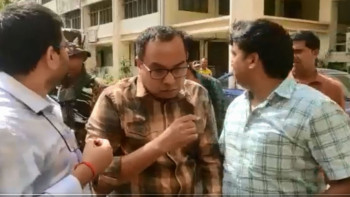Gas supply falls to near zero at places

Shawdesh desk:
The supply of piped gas to households has reduced to almost zero in many areas of the capital Dhaka and adjacent localities while many industries in the areas have also made similar complaints.
Authorities, however, say that they are providing the best gas supply in years this December, almost at their optimum capacity, suggesting no improvement in the situation anytime soon.
In less than three months, when the brief winter will be over with the onset of the hottest time of year, the energy situation may worsen with the demand set to increase by at least 70 per cent.
Bangladesh grapples with a prolonged economic crisis partly caused by energy imports that deplete its foreign currency reserve.
The acute gas crisis disrupted daily lives, complained household and commercial consumers, by making them spend more on food and essential items.
‘We are running at 30 per cent capacity,’ Mahmud Group general manager Sudhangshu Kumar Dutta told New Age.
His factory at Shafipur in Gazipur has a pipeline with a receiving capacity of 150 pounds per square inch.
‘The actual supply now stands at 1 or 2 PSI,’ he said.
Mahmud Group let go of a garment factory with more than 4,000 employees due to continued production loss owed to inadequate supply of energy.
Bangladesh has been largely dependent on gas for energy for decades amidst poor exploratory works in the world’s largest delta, believed to be a decent gas reserve.
The discovered fields have run dry and are close to stopping production.
Starting in 2018, Bangladesh saw its foreign currency reserve to deplete fast after beginning to import liquefied natural gas.
‘This is the best we could do. We are operating at our maximum capacity,’ said Petrobangla chairman Zanendra Nath Sarker, adding that the supply situation would remain the same until February.
The state-owned Petrobangla supplied 2,755.7mmcfd in the 24 hours until Tuesday morning. The demand is officially estimated to be 4,000mmcfd.
On Tuesday, the Petrobangla supplied 851.5mmcfd to power production, meeting only 34 per cent of the demand, and 204.8mmcfd to fertilizer against the demand of 329mmcfd.
Winter is the time the government tries to feed gas to fertilizer production as the energy demand in the power sector falls because of cold weather. The supply to the fertilizer sector was increased by about 80mmcfd compared with the summer-time supply to the sector.
‘The crisis defeated our worst imagination,’ said Hamida Banu, a resident of Uttar Badda.
For the past several days, Uttar Badda residents received almost no gas throughout the day and a good part of the night. In the wee hours of day, some areas received a weak flow not enough to boil an egg regardless of the time cooked.
‘All residents of 40 flats in my apartment building could not cook over the past several days,’ said Nur Hossain, a caretaker of an eight-storied building in Uttar Badda.
Similar complaints poured in from Mohammadpur, Kathalbagan, Mirpur, Central Road, Gendaria, and Rampura.
These areas used to get piped gas supply from dusk to dawn, but nowadays they are denied supply for even longer hours.
The worst outcome of the energy crisis is that the consumers of piped gas are paying despite no supply. Piped gas prices are fixed based on an assumed monthly consumption.
The consumers even continue paying the same as they do during normal gas supply, they alleged.
The speculation that the government wants households to switch to liquefied petroleum gas turned into a reality with many piped gas consumers using LPG as an alternative energy source.
After the government stopped giving new piped gas connections to households in 2010, the import of LPG topped 10 lakh tonnes in 2020 from 60,000 tonnes 10 years ago.
Household consumers consume 15 per cent of piped gas supplied through the same transmission network shared by industrial and commercial consumers.
Households get weak flow round the year competing with big industrial consumers. Less supply often prompts household consumers to undertake unethical means to get their fair share of gas, many consumers alleged.
The affluent segment of the society may dine out when gas supply falls but low-income people cannot afford such luxury and they either fast or stay half-fed, they said.
‘We have meals once a day,’ said Dulna Rani, a housemaid in Mirpur, who shares a kitchen with about a dozen families and cannot afford to cook twice in a weak flame after working 10 hours outside home.
The deposed government increased the gas price several times between 2019 and 2023. In one of the occasions, the gas price for industries was increased by about 180 per cent.
The cost increased but the supply did not improve, many consumers said.
On Tuesday, the LNG supply was 830.9mmcfd against the capacity of 1,000mmcfd.
Titas, which supplies piped gas to 70 per cent of about 4 million household consumers, said that the gas supply suddenly dropped by 150mmcfd, particularly over the past several days.
Titas needs a minimum 2,000mmcfd to meet the demand in Dhaka, Titas officials said, adding that over the past several days, the supply remained below 1500mmcfd.





























Leave a Reply